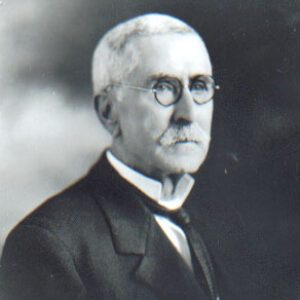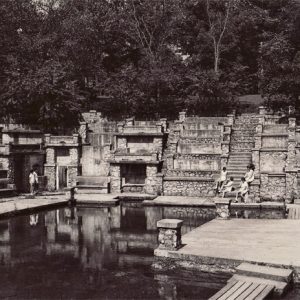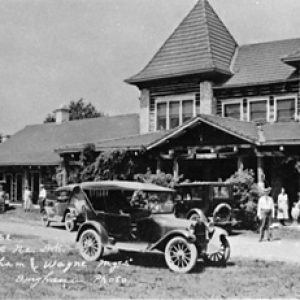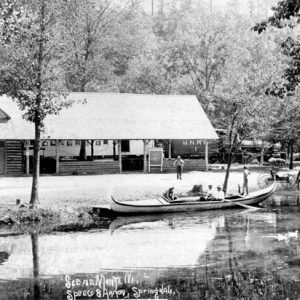calsfoundation@cals.org
"Coin" Harvey (1851–1936)
aka: William Hope Harvey
William Hope “Coin” Harvey founded both the resort of Monte Ne (Benton County) and the Ozark Trails Association, establishing him as a pioneer in the promotion of Arkansas tourism. Harvey was also the 1932 Liberty Party nominee for the president of the United States.
Coin Harvey was born on August 16, 1851, on a farm near Buffalo, Virginia (now West Virginia), to Robert Trigg and Anna Hope Harvey. He attended the country schools and Buffalo Academy in 1865–67, and then briefly taught school. While teaching, he studied law and briefly attended Marshall College in Cabell County, West Virginia, in 1867. In 1870, he was admitted to the bar.
Harvey began his law career in West Virginia but soon moved on to Gallipolis, Ohio, where he married Anna R. Halliday on June 26, 1876; they had four children. The couple spent much of their married life on the move. Harvey practiced law in Cleveland, Ohio, and Chicago, Illinois, before returning briefly to Gallipolis.
In 1884, Harvey took his family to Ouray, Colorado, where he operated the Silver Bell, one of the most productive silver mines in the Red Mountain district. When the price of silver fell, Harvey abandoned mining and, in 1888, moved his family to Pueblo, Colorado, where he practiced law, sold real estate, and helped develop the Mineral Palace, an ornate exposition hall. By 1891, the family moved to Ogden, Utah, where Harvey led the organization of an extravagant carnival that ended in financial failure.
In the early 1890s, as the nation entered a period of deflation, bank failures, bankruptcies, and farm foreclosures (the Panic of 1893), Harvey turned his attention to the free silver issue. Like other western business leaders, he believed that abandoning the gold standard and returning to the free coinage of silver would restore prosperity. In 1893, Harvey moved his family to Chicago to devote his time to the cause. He began writing and lecturing, arguing that the U.S. Treasury should buy all silver offered at a set price and issue silver certificates backed by the deposits.
In 1894, Harvey wrote the tremendously successful book, Coin’s Financial School, in which a fictional young financier named “Coin” presented the arguments in favor of silver. This book brought him fame, fortune, and his nickname, “Coin.” Other publications followed, and Harvey became a spokesman for the free silver cause. During the 1896 presidential race, he campaigned for William Jennings Bryan, the Democratic free silver candidate. Bryan lost the election, but Harvey remained an influential political figure.
Harvey had campaigned for Bryan in northwestern Arkansas and noticed that the area had no large cities or extremely wealthy people. In 1900, he purchased acreage around a village then called Silver Springs, five miles southeast of Rogers (Benton County). He announced plans to build a resort around the community. Harvey renamed the area “Monte Ne,” which he said were the Spanish and Native American words for “mountain” and “water.”
Soon after the Harveys moved to Arkansas, their house burned. His wife returned to Chicago, and the couple never again lived together. Harvey continued work on his luxurious resort. By May 1901, the Hotel Monte Ne was completed. Within a few years, the resort had expanded to include two more hotels, a tennis court, and the first indoor swimming pool in Arkansas. Harvey built a railroad spur (the Monte Ne Railway) linking Monte Ne to the St. Louis–San Francisco Railway line and purchased a gondola from Italy to ferry tourists from the depot across a spring-fed lagoon to the hotels.
In 1913, Harvey formed the Ozark Trails Association (OTA). Although the association’s stated purpose was the promotion of better roads, Harvey’s goal was the promotion of Monte Ne. The OTA marked routes, published route books, and erected obelisks that were lettered with the distance and direction to Monte Ne at major junctions. Despite the efforts, the association did little to increase business at the resort. Like many resorts, Monte Ne suffered with the growth of automobile travel, and in the 1920s, most of the resort was sold or foreclosed.
With the exception of a failed Democratic primary bid in the 1913 congressional election, Harvey generally avoided politics after moving to Arkansas. But he continued to write on political and economic issues. Among his works were The Remedy (1915), Common Sense (1920), and Paul’s School of Statesmanship (1924). In his later years Harvey became increasingly pessimistic. Convinced that the fall of civilization was imminent, he announced plans in the 1920s for the construction of a “pyramid,” a 130-foot-tall obelisk that would contain his warning to future generations. Harvey never completed the project but did construct an amphitheater that was to have been the pyramid’s “foyer.”
Harvey often had written against the evil of divorce, but in 1929, after nearly three decades of living apart, he obtained a divorce from his wife. He married his secretary of many years, May Leake, that same year.
Three years later, he again appeared in the national spotlight when he ran for president of the United States. Harvey founded the Liberty Party in 1931 because he was convinced the two major parties had become indistinguishable. While it shared a name with the earlier Liberty Party, this new third party was focused on economic reform. Although eighty years old, Harvey was the only candidate the delegates would support at the Liberty Party national convention held at Monte Ne in 1931.
The party platform was based on Harvey’s writings and called for government ownership of utilities and industry, limits on land holdings and personal wealth, and, of course, free silver. When the votes were tallied, he was in sixth place, with over 53,000 votes, of which 1,049 were from Arkansas.
Harvey died at Monte Ne on February 11, 1936, and was buried beside one son in a concrete tomb. Today, most of Monte Ne is beneath the waters of Beaver Lake, which was created in the 1960s by damming the White River. Before the lake was filled, Harvey’s tomb was moved up the hillside.
For additional information:
Crowder, Nathan. “Sunken Dreams: William ‘Coin’ Harvey and Monte Ne, Arkansas.” MA thesis, University of Arkansas, 2009.
Lawler, Nan. “The Ozark Trails Association.” MA thesis, University of Arkansas at Fayetteville, 1999.
Nichols, Jeanette P. “Bryan’s Benefactor: Coin Harvey and his World.” Ohio Historical Quarterly 67 (October 1958): 299–325.
Paschal, Olivia. “The Coin Standard: On the Failed Dreams and Forgotten Ruins of William Hope Harvey.” Lapham’s Quarterly, December 15, 2021. https://www.laphamsquarterly.org/roundtable/coin-standard (accessed December 17, 2021).
Stokes, Harry A. “William Hope Harvey: Promoter and Agitator.” MA thesis, Northern Illinois University, 1965.
William H. “Coin” Harvey and Monte Ne Collection. Research Library. Rogers Historical Museum, Rogers, Arkansas.
Gaye Bland
Rogers Historical Museum
This entry, originally published in Arkansas Biography: A Collection of Notable Lives, appears in the CALS Encyclopedia of Arkansas in an altered form. Arkansas Biography is available from the University of Arkansas Press.
 Business, Commerce, and Industry
Business, Commerce, and Industry Early Twentieth Century, 1901 through 1940
Early Twentieth Century, 1901 through 1940 Politics and Government
Politics and Government Coin Harvey
Coin Harvey  Monte Ne Amphitheater
Monte Ne Amphitheater  Monte Ne Club House Hotel
Monte Ne Club House Hotel  Monte Ne Train Depot
Monte Ne Train Depot 




Comments
No comments on this entry yet.